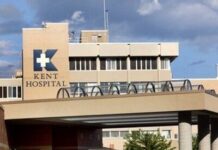MINNEAPOLIS – Medtronic PLC’s decision to move its tax address out of the U.S. is already starting to pay dividends.
The medical device company used a deal with Covidien Plc this year to shift its legal address from Minneapolis to Dublin, freeing up $9.3 billion in profits generated overseas that otherwise would have been subject to U.S. taxes. The deal was the biggest so-called tax inversion in U.S. history, though Pfizer Inc.’s deal to buy Allergan PLC, which could close next year, would be larger.
Medtronic bought Covidien PLC for $49.9 billion in January, and an internal reorganization of the two legal entities freed up about $9.8 billion in cash, Chief Financial Officer Gary Ellis said Thursday. The company will pay about $450 million in taxes to bring it to the U.S., he said, far less than if a U.S.-domiciled Medtronic had tried to bring the money back.
“Cash that Medtronic couldn’t use in the U.S. is now available for research and development, acquisitions or return to shareholders,” Ellis said in a telephone interview after the company’s fiscal second-quarter earnings. “We hope as we go forward we’ll be able to do more of this.”
The U.S. has the developed world’s highest corporate tax rate, of 35 percent. It taxes earnings no matter where they’re made. That means profits that U.S. companies earn overseas face an additional U.S. tax of up to 35 percent, while companies based in many other countries don’t have to pay any additional amount on their foreign profits. It’s a system that’s prompted U.S. companies to buy smaller overseas companies, using the transactions to shift their legal addresses to lower-tax jurisdictions.
Tax reform
Tax reform has been a major issue in the U.S. political system, with presidential candidates and lawmakers from both sides of the aisle calling for change — so far with little result. Medtronic’s new domicile doesn’t alleviate the need for reform, said CEO Omar Ishrak. Medtronic still has 40 percent of its cash trapped abroad, he said. In July, the company said it had $17.7 billion in cash, equivalents and marketable securities permanently reinvested outside the U.S.
The company is discussing its plans for the cash with its board, Ishrak said, focusing on paying down debt and share repurchases. It is already helping buy new technology and fund acquisitions in high-growth areas, he said. Medtronic plans to give additional details in the near future, he said.
“We are creating jobs in the U.S. and giving oxygen to the medical technology industry, especially early-stage companies,” Ishrak said. “As a result of this structure we are able to invest much more in early stage and mature technology in the U.S. than we were before, as well as increase our shareholder returns.”
Covidien integration
Earlier Thursday, Medtronic reported profit for the fiscal second quarter, excluding one-time items, of $1.03 a share, beating the $1.00 average of analysts’ estimates. Medtronic shares rose 2.7 percent to $78.15 at 11:47 a.m. in New York.
The integration of Covidien is also going well in other areas, the two executives said. Medtronic has pledged to cut $850 million in costs from its spending by 2018 and is on track or slightly ahead of that pace. It has already trimmed about 40 percent of the $300 million to $350 million it plans to cut this year, Ellis said.
The savings stemmed from eliminating 80 duplicate sites, including back-office operations and distribution centers, getting additional savings from vendors based on its greater purchasing power and integrating the two company’s operating systems.
The executives are now looking at different segments of the Covidien portfolio, particularly the minimally invasive therapies group, to determine which align best with Medtronic’s corporate mission, Ishrak said. The reviews are done regularly within the company’s product lines, and the new assets from Covidien are less known, he said.
“The next step is to see what fits and what doesn’t,” Ishrak said. “Some things clearly don’t,” and the company will decide what to do with those assets in the next six months, he said.












